By definition, a celestial body refers to any natural object that exists beyond the boundaries of the Earth’s atmosphere. Examples include the moon, the sun, and the planets in our solar system. However, these examples only scratch the surface. There are many celestial bodies in the Kuiper Belt, and any asteroid within the universe qualifies as one. This article will present the essential information about celestial bodies simply.
Celestial Bodies
Celestial bodies, also known as heavenly bodies, are objects that inhabit the universe – such as the sun, the moon, the planets, and the multitude of stars. They are part of the vast universe we live in. The night sky, with its myriad twinkling points, is adorned with these objects. When viewed through a telescope, they look mesmerizing. Given their great distance from us, not all celestial bodies are visible to the naked eye, making it necessary to use telescopes for their study. The universe is a vast storehouse of celestial or astronomical objects. Although the majority of the universe is made up of space, this cold, dark void contains a variety of astronomical entities, ranging from the familiar to the extraordinary. These celestial bodies are the substances that fill the vast void of the universe.
While we are well acquainted with stars, planets, and moons, there are also many other astronomical wonders to observe. These include vibrant nebulae, complex star clusters, and massive galaxies. Pulsars and quasars add even more mystery to the cosmic tapestry. Additionally, black holes swallow any matter that comes too close. The search for mysterious, invisible entities known as dark matter continues.
Classification of Celestial Bodies
Stars
Stars are huge balls of hot gases that are capable of producing their light. They emit energy by transforming hydrogen into helium in their cores. Stars are huge, with significant gravitational pull. Our Sun, a medium-sized star, provides the energy that sustains life on Earth.
Planets
Planets are large, spherical bodies that orbit the Sun and move along fixed paths called orbits. There are eight planets in our solar system. These planets may contain rocks, metals, and gases such as hydrogen, nitrogen, and methane. Earth, a planet in our solar system, is the only known place in the universe where life exists. Planets orbiting other stars are called exoplanets.
Satellites
Satellites are objects that orbit planets and play important roles in the structure of many celestial bodies. The satellites can be natural or artificial. The Moon, Earth’s natural satellite, orbits the planet due to Earth’s gravitational pull. Humans have also placed artificial satellites around Earth and other planets for research and communication purposes.
Comets
Comets are small pieces of ice and rock that originate from the outer regions of the solar system. As they approach the Sun, the ice on their surface vaporizes, leaving a fascinating tail behind them.
Asteroids
Asteroids are small, irregularly shaped rocks made of metal or minerals that orbit the Sun. Most asteroids are located in a region known as the asteroid belt between Mars and Jupiter.
Meteors and Meteoroids
Meteors are objects from space that enter Earth’s atmosphere when pulled by the planet’s gravitational pull. These objects often burn up as they enter, creating streaks of light in the sky, often called “shooting stars.” If a meteor is large enough, it can reach Earth’s surface, creating a crater. Such objects are known as meteoroids.
Galaxies
Galaxies are huge groups of stars bound together by gravity. The Sun and our solar system are part of the Milky Way galaxy. Other galaxies are usually so far away that they appear as mere points of light in the night sky. The Andromeda Galaxy and the Large Magellanic Cloud are galaxies that are visible to the naked eye on a clear night.
Frequently Asked Questions
Question: What are celestial bodies?
Answer: Celestial bodies or heavenly bodies refer to planets, stars, moons, and all other natural objects that exist in space.
Question: How many types of celestial bodies exist?
Answer: Celestial bodies include:
- Planets
- Stars
- Satellites
- Comets
- Asteroids
- Meteoroids and meteoroids
- Galaxies
Question: Where are most asteroids found?
Answer: Most asteroids reside in the asteroid belt, a region located between Mars and Jupiter.
Question: What are comets?
Answer: Comets are small pieces of ice and rock from the outer edge of the solar system. As they approach the Sun, the ice on their surface vaporizes, creating a spectacular tail. Halley’s Comet, one of the most famous comets, appears from Earth every 75-76 years.
Question: Which galaxy do we belong to?
Answer: The Sun and our solar system are part of the Milky Way galaxy.
Question: What is the main difference between planets and stars?
Answer: Unlike planets, stars produce their light. Planets only reflect the light emitted by a star like the Sun.




